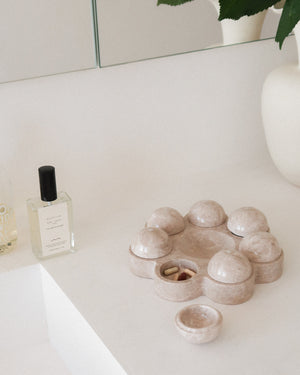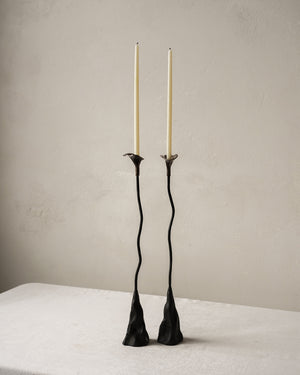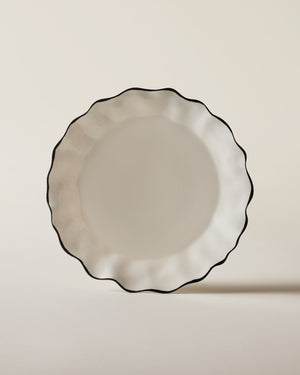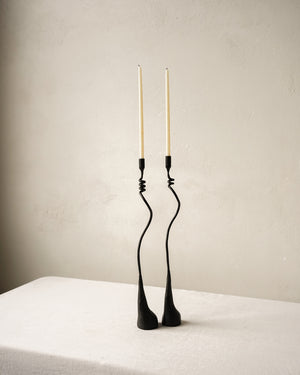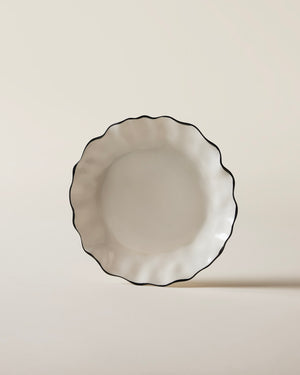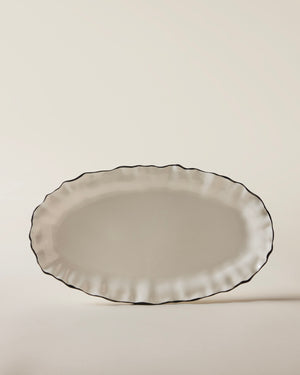STUDIO VISIT WITH LAUREN SKUNTA

Words by Brienne Walsh, Images by Kelly Shaffer
When Lauren Skunta received her BFA in painting, her professors told her it was almost impossible to make a living as a painter. If she did paint, they told her, she'd likely have to wait tables to make ends meet. For a while, Skunta did wait tables before she got a full-time job designing window displays for Anthropologie. Eventually, she founded Elbow Grease Design, which created sculptural installations for clients featured in Harper's BAZAAR, Martha Stewart Magazine, and Style Me Pretty, among other publications.
But Skunta, based in Cleveland, Ohio, never forgot her first love, painting. She recently began working on the large-scale figurative nudes she's always dreamed about painting. Rendered in muted earth tones and featuring groupings of nude women, the compositions are redolent of the nudes by Helen Frankenthaler and Jenny Saville. Like the former, Skunta makes sophisticated use of blank space on the canvas, as well as charcoal lines combined with paint to create airy depth.

Skunta currently has some of her large-scale figurative paintings on sale through LES Collection. Below, she talks about her process and why she paints the female nude, a historically weighty subject matter.
How did you first get in touch with LES Collection?
Lauren Skunta: I actually reached out to Lauren Sands myself. Along with being a painter, I'm also an art director and set stylist at a commercial photography studio. I was prop sourcing and came across LES's website and was just like, 'Oh, this is identical to the style I love and what my paintings represent." So, I contacted Lauren and asked if I could send my painting portfolio. She immediately got back to me, and the rest is history.


|
Emerge |
Boscage |
Did you always know you were an artist, even as a young child?
LS: Yes, absolutely. My mom always tells this story — when she was enrolling me in preschool, I went to see an evaluator to ensure I was ready for school. The evaluator had me draw some pictures. When we finished, my mom was worried because the person was leading me back to her by the hand. My mom was like, "Oh, no, what happened?" The evaluator said, "No, I just wanted to show you this artwork that Lauren did." Most kids apparently draw a person that's like a stick figure. And mine had a full outfit on with eyelashes and accessories. So the evaluator told my mom to take me to art lessons, and she did.

After receiving your BFA from Ohio State in painting, you then went on to work at Anthropologie in New York as a display coordinator. Why did you pursue this career?
LS: In art school, they always tell you that making a living as an artist is very difficult. They say it can be done, but you shouldn't expect it right out of the gate. I was always like, okay, I'm willing to wait, but I definitely want a creative career. And regardless, I must do my art on the side. I knew that Anthropologie hired people to create their window displays, so I reached out to them after graduation. When I was younger, I worked at a woodshop. And my whole family is very mechanical — I'm related to many car mechanics. So I was always around power tools. So, I knew I could do installations using a lot of different materials. After six months, they asked me if I wanted to take an open position as a display coordinator at an Anthropologie in Long Island. It was my dream job. I couldn't believe I got to make things for a living. It was intense, and I eventually got burned out, but it gave me the confidence to make my own art and sell it. Every Anthropologie display coordinator I met in New York now has their own business because, as an employee there, it was like you were running a small business on your own anyway.


|
Careen |
Flume |
How has your painting practice evolved over the years?
LS: In art school, I learned that you have to let the painting naturally flow out of you. But I've found that I get much better results if I plan the composition. Typically, a composition starts with a few sketches of live models. I find capturing the ephemeral quality of a sketch on a large canvas intimidating, so I recently began projecting my sketches onto the canvas and arranging the figures to overlap how I want. Using my knowledge of composition, I can see, for example, that a figure needs to move two inches downward. I don't feel like I'm cheating because they're my sketches. It's just silly not to use the tools at your disposal. I'm always working on three to eight canvasses at one time. While the paint is drying on one, I'll pop another on my easel. For the color palette, I feel most at home with neutrals. I connect most with colors from the earth.

The female nude is a weighted subject that men have historically painted. What is your hope that your paintings convey to the viewer?
LS: I don't think I'm trying to make any statement as far as women's bodies. I tend to draw models with a similar body type to myself. It is not something I intentionally do. I think it's a way of self-acceptance, like I'm drawing myself through them. I also definitely want to normalize nudity. There is something very freeing about the naked body. It conveys, "This is exactly who I am. I'm not done up at all." That's cool. It just feels beautiful to me.


|
Akimbo |
Linwork |
Are there any topics you hope to explore in the future?
LS: For now, I'm going to stick with female figures. That's where my heart is. I don't want public opinion to influence what I want to make. Most of the work I've been producing has been medium-scale because of my small studio's constraints and worries about price points. But I am interested in exploring larger scales; I'm excited about my paintings on sale through LES Collection.


